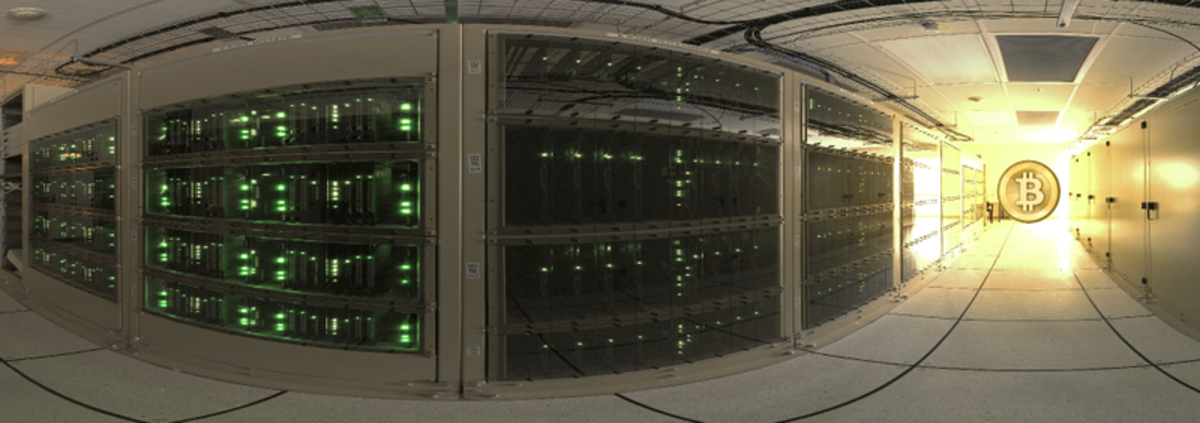
This article was written by Ruben Alexander and Brian Cohen
The NSF or National Science Foundation Office of the Inspector General (OIG) just posted on their website their March 2014 Semiannual Report to Congress (PDF with metadata create date of 5/27). This report contains a write-up on an “Administrative Investigation” by the OIG entitled “Government-wide Suspension Recommended for Researcher Who Used NSF-Funded Supercomputers to Mine Bitcoins” (full extract at bottom).
The National Science Foundation according to its website is “an independent federal agency created by Congress in 1950 ‘to promote the progress of science; to advance the national health, prosperity, and welfare; to secure the national defense…’”
According to a “Special Report” from NSF, “From SuperComputing to the Terragrid” (Mirror) a 1982 report “Large Scale Computing in Science and Engineering” (PDF) by Peter D. Lax affectionately referred to as the “The Lax Report” (under the sponsorship of the Department of the Defense [DOD] and the National Science Foundation), “led to the emergence of significant new NSF support for high-end computing, which in turn led directly to Supercomputer Centers.”
Recent supercomputing breakthroughs include “NSF-funded Superhero Supercomputer {That} Helps Battle Autism.” The computer referred to as ‘Gordon’ uses unique flash memory to assist in identifying gene-related paths to treating mental disorders according to the March 26, 2013 press release. NSF also supports the “Unique, High-Performance Supercomputer Center,” the PRObE Center of Los Alamos, “the world’s first supercomputing system for large-scale systems research” according to another press release from October 24th, 2012. The OIG report does not mention the supercomputer research facilities whose computer resources were misappropriated (nor the name of the professor who did the deed) and we have no reason to believe that either of these facilities were involved in the breach.
In fiscal year 2014, NSF’s annual budget is $7.2 billion and the Foundation funds almost a quarter of all federally supported basic research conducted by America’s colleges and universities.
Absurdness of Mining Bitcoin Right Now with a Supercomputer
In December 2013, Nathaniel Popper of the New York Times interviewed Michael B. Taylor, a professor at the University of California, San Diego, UCSD Center for Dark Silicon for his article “Into the Bitcoin Mines.” Professor Taylor explained that:
“Today, all of the machines dedicated to mining Bitcoin have a computing power about 4,500 times the capacity of the United States government’s mightiest supercomputer, the IBM Sequoia. The computing capacity of the Bitcoin network has grown by around 30,000 percent since the beginning of the year.”
We caught up with Professor Taylor who provided an update on these metrics:
“Today, all of the machines dedicated to mining Bitcoin have a computing power about 58,600 times the capacity of the United States government’s mightiest supercomputer, the IBM Sequoia…{note: now second most powerful after “Titan” according to Top 500} …The computing capacity of the Bitcoin network has grown by around 1,300 percent since the beginning of the year.”
Professor Taylor also happens to be a NSF funded researcher (of no relation to the professor who misappropriated the use of supercomputers to mine for bitcoin). His 2013 research paper “Bitcoin and The Age of Bespoke Silicon” was partially supported by NSF Awards.
Professor Taylor said that the “NSF is generally interested in the advancement of science, which includes cryptocurrencies and many other exciting developments in the scientific world.”
Indeed, NSF funded (in part) well known research by Nicolas Christin of Carnegie Mellon INI/CyLab, “Traveling the Silk Road: A Measurement Analysis of a Large Anonymous Online Marketplace“ (PDF), University of California and San Diego George Mason University researchers papers “A Fistful of Bitcoins: Characterizing Payments Among Men with No Names” (PDF) and “Botcoin: Monetizing Stolen Cycles” (Ref: “Using stolen computer processing cycles to mine Bitcoin”) as well as research such as Doctoral Dissertation Research: Making Real Money: Local Currency and Social Economies in the United States” with a stipend of $5,227 which was awarded in 2005 and “NeTs: Small: Economic Incentives for P2P: Theory and Design” awarded in July 2010 with a total of $466,000 awarded towards NeTs to date (and expiring this August).
We asked Michael about the “futility” of mining bitcoin with a supercomputer and he told us that:
“In a day, Sequoia could mine about 40 dollars worth of bitcoin, but it consumes about the same amount of electricity as 4,000 homes: 8 megawatts. They would pay more money in electricity costs each day than they would earn.”
Using a Supercomputer to mine for bitcoin is both appalling and shocking to common sense. That said, we are uncertain of the exact metrics to use to extrapolate the efficiencies (or lack of thereof) of mining for bitcoin during the period in question. However, that won’t stop us from trying to second guess the scant data provided by the OIG report (FOIA request anyone?).
The only computers designed to efficiently mine for bitcoin are ASIC or Application-Specific Integrated Circuit “mining rigs” (a.k.a computers). One such rig produced by KnCMiner costs approximately $6,000 and “minimum 3000GH/s of hashing speed that 3TH.” Eric Turner, founder of CoinChomp estimates that Neptune should consume 4,500 Watts. The current price tag for the IBM Sequoia supercomputer cost close $250 million dollars. To create its electricity, cost is estimated at $9 million a year or about $24,655 per day according to Steve Henn at NPR.
It is likely the $150,000 mentioned in the OIG report as “NSF-supported computer usage” was the electrical cost of mining on the supercomputer or potentially mining for 6 full days.
While mining on hardware designed for processing Bitcoin transactions is the most efficient way to mine Bitcoin, the supercomputer was most likely chosen for its availability and the electrical costs were not paid by the miner. The only steps necessary to mine Bitcoin are installing software designed to process SHA-256 hashes and configuring that software to mine on a specific mining pool.
There may have been additional measures taken to hide login access to the computer, but it would have been difficult to hide the supercomputer’s power consumption while mining for Bitcoins.
History Repeats Itself
This may or may not have been the first time a supercomputer was misused to mine for Cryptocurrency. Theodore R. Delwiche reported on February 20, 2014 in The Harvard Crimson that “Harvard Research Computing Resources Misused for ‘Dogecoin’ Mining Operation:”
“A member of the Harvard community was stripped of his or her access to the University’s research computing facilities last week after setting up a “dogecoin” mining operation using a Harvard research network, according to an internal email circulated by Faculty of Arts and Sciences Research Computing officials.”
One of the earliest references we could find for the misappropriation of computer time was an interesting case from 1967. According to Paul Andrews, in his 1994 biography “Gates: How Microsoft’s Mogul Reinvented an Industry–and Made Himself the Richest Man in America,” a “runty freckle-faced eighth grader” known by the name of Bill Gates punked C-Cubed computer company while learning the computer programming language BASIC. Gates and his fellow students had become “addicted to programming.” Even though Gates received a 20 percent educational discount, computer “time sharing” costs became too costly. “Real people had to pay for computing time” but “Accessing the accounting files, where the passwords were stored, seemed like just another challenge…Bill Gates and his friend Paul Allen were clearly the ringleaders.” Andrews wryly explains “The kids were testing the system, just doing a little digital shoplifting. What harm was there in appropriating unused computer time protected with only the flimsiest of barriers?”
While Bill, Paul and company were banned from the computers for the summer, it’s not known if our present day Bitcoin pirate was technically “debarred” under the “Office of Federal Contract Compliance.” The OIG has a section of the report which discusses “Total Accountability: Suspension, Debarment and Beyond” and mentions debarments in “Civil and Criminal Investigations” and “Research Misconduct Investigations.” Our computing power thief is not one of them as this was listed as an “Administrative Investigation” none of which involved a debarment. According to the report, NSF “suspended” the researcher “government-wide.” The suspension is assumed to be indefinite as there was no time-frame provided.
If he only used his brain, he would have never gotten into this mess!
Full Extract from the National Science FoundationOffice of the Inspector General March 2014 Semi Annual Report to Congress:
Government-wide Suspension Recommended for Researcher Who Used NSF-Funded Supercomputers to Mine Bitcoins
We received reports describing a researcher’s abuse of NSF-funded supercomputing resources at two universities to conduct bitcoin mining activities. Bitcoin is a virtual currency that is independent of national currencies, but it can be converted into traditional currencies through exchange markets. It is generated or “mined” through a process that is by design computationally intensive.
The researcher misused over $150,000 in NSF-supported computer usage at two universities to generate bitcoins valued between $8,000 and $10,000. Both universities determined that this was an unauthorized use of their IT systems. The researcher asserted that he was conducting tests on the computers, but neither university had authorized him to conduct such tests — both university reports noted that the researcher accessed the computer systems remotely and may have taken steps to conceal his activities, including accessing one supercomputer through a mirror site in Europe.
The researcher’s access to all NSF-funded supercomputer resources was terminated. In response to our recommendation, NSF suspended the researcher government-wide.
Image (altered) via Wikipedia










